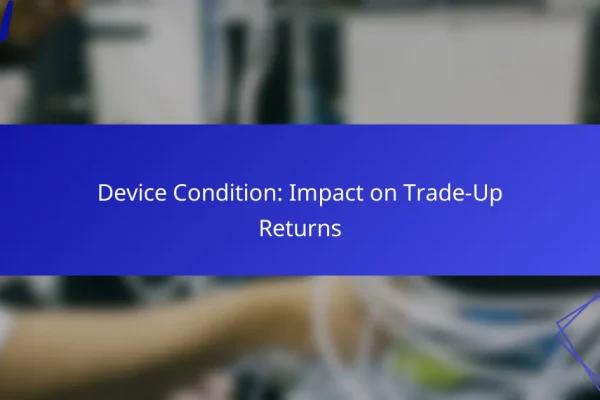How to maximize trade-up returns in e-commerce?
To maximize trade-up returns in e-commerce, focus on strategic product selection, pricing, and customer engagement. Implementing effective methods can significantly enhance profitability and customer satisfaction.
Utilize customer feedback for product selection
Gathering and analyzing customer feedback is essential for selecting products that resonate with your audience. Use surveys, reviews, and social media interactions to identify preferences and pain points. This data-driven approach helps in curating a product lineup that meets market demand.
For instance, if customers frequently request a specific feature, consider prioritizing products that incorporate that feature. Regularly updating your offerings based on feedback can lead to higher trade-up rates.
Implement dynamic pricing strategies
Dynamic pricing involves adjusting prices based on market demand, competition, and customer behavior. This strategy can maximize trade-up returns by ensuring that prices reflect the perceived value of products at any given time. Utilize pricing tools that analyze competitor pricing and customer trends to optimize your pricing strategy.
For example, during peak shopping seasons, consider raising prices slightly to capitalize on increased demand. Conversely, offering discounts during off-peak times can attract more customers and encourage trade-ups.
Leverage loyalty programs for repeat customers
Loyalty programs incentivize repeat purchases, which can significantly boost trade-up returns. By rewarding customers for their loyalty, you encourage them to choose higher-value products. Implement tiered rewards that increase with customer spending to motivate upgrades.
For example, offer points for every purchase that can be redeemed for discounts on future trade-ups. This not only fosters customer loyalty but also increases the likelihood of higher-value transactions.
Optimize product bundling offers
Product bundling involves grouping related items together at a discounted price, which can enhance perceived value and encourage trade-ups. This strategy can increase average order value while providing customers with a compelling reason to purchase more. Identify complementary products that align with customer needs for effective bundling.
For instance, if you sell electronics, consider bundling accessories with devices. Offering a slight discount on the bundle compared to purchasing items separately can entice customers to opt for the trade-up option.
What are the best practices for trade-up strategies?
To maximize trade-up returns, focus on understanding market dynamics and selecting the right products. Implementing effective strategies involves analyzing trends, targeting high-margin items, and being aware of the risks associated with trading up.
Analyze market trends for high-demand products
Identifying high-demand products is crucial for successful trade-up strategies. Regularly monitor market trends through platforms like eBay or Amazon to see which items are gaining popularity. Tools such as Google Trends can also provide insights into consumer interest over time.
Consider seasonal trends and consumer behavior shifts, as these can significantly impact demand. For instance, electronics often see spikes during holiday seasons, while fashion items may trend with changing seasons. Stay informed to make timely trade-up decisions.
Focus on high-margin items for trade-ups
High-margin items are essential for maximizing profit during trade-ups. Look for products that have a significant difference between their purchase and resale prices. For example, limited edition sneakers or collectible items often yield higher returns compared to everyday goods.
Evaluate the cost-to-value ratio carefully. Aim for items that can be purchased at a lower price but have a strong resale potential, ideally with margins exceeding 20-30%. Avoid items with high competition unless you have a unique advantage in sourcing or marketing.
How can data analytics improve trade-up returns?
Data analytics can significantly enhance trade-up returns by providing insights into inventory management and customer behavior. By leveraging predictive analytics and tracking consumer patterns, businesses can optimize their offerings and marketing strategies to maximize profits.
Use predictive analytics for inventory management
Predictive analytics helps businesses forecast demand and manage inventory more effectively. By analyzing historical sales data and market trends, companies can identify which products are likely to be in demand and adjust their stock levels accordingly.
For instance, if data shows a consistent increase in demand for a specific product during certain seasons, businesses can increase their inventory ahead of time. This proactive approach minimizes stockouts and overstock situations, leading to better trade-up opportunities.
Track customer behavior for targeted promotions
Tracking customer behavior allows businesses to create targeted promotions that resonate with their audience. By analyzing purchase history and browsing patterns, companies can tailor their marketing efforts to specific customer segments, increasing the likelihood of successful trade-ups.
For example, if a customer frequently purchases high-end electronics, a business might offer them exclusive trade-up deals on newer models. This personalized approach not only boosts sales but also enhances customer loyalty, leading to higher overall returns.
What are the key metrics for measuring trade-up success?
Key metrics for measuring trade-up success include return on investment (ROI) and customer acquisition cost (CAC). These metrics help businesses assess the effectiveness of their trade-up strategies and identify areas for improvement.
Monitor return on investment (ROI)
Return on investment (ROI) is a critical metric that evaluates the profitability of trade-up initiatives. To calculate ROI, divide the net profit from the trade-up by the total costs associated with the trade-up effort, then multiply by 100 to get a percentage. A positive ROI indicates a successful trade-up strategy.
Consider setting a benchmark for ROI based on industry standards. For many sectors, an ROI of 20% or higher is often considered strong. Regularly monitoring ROI can help identify trends and inform future trade-up decisions.
Evaluate customer acquisition cost (CAC)
Customer acquisition cost (CAC) measures the total expense incurred to acquire a new customer through trade-up efforts. This includes marketing expenses, sales team costs, and any promotional discounts offered. To find CAC, divide the total acquisition costs by the number of new customers gained during a specific period.
Keeping CAC low is essential for maintaining profitability. Aim for a CAC that is significantly lower than the lifetime value (LTV) of a customer. A common rule of thumb is to maintain a CAC that is one-third or less of the LTV to ensure sustainable growth.
How do trade-up returns vary by region?
Trade-up returns can significantly differ by region due to variations in consumer demand, market saturation, and local economic conditions. Understanding these regional differences is crucial for maximizing returns on trade-up investments.
Analyze regional demand for specific products
To effectively analyze regional demand, start by researching which products are most sought after in different areas. For instance, luxury items may have higher demand in urban centers compared to rural locations. Utilize market reports and consumer surveys to identify trends and preferences.
Consider factors such as local income levels and cultural influences that can impact product desirability. For example, in regions with higher disposable income, premium brands may yield better trade-up returns.
Adjust marketing strategies based on local preferences
Tailoring marketing strategies to fit local preferences can enhance trade-up returns. This includes adjusting messaging, promotional tactics, and even pricing strategies to resonate with regional consumers. For instance, using local languages or cultural references can improve engagement.
Additionally, consider seasonal trends and local events that might influence buying behavior. For example, promoting specific products during local festivals or holidays can lead to increased sales and better trade-up opportunities.
What are the challenges in maximizing trade-up returns?
Maximizing trade-up returns involves navigating various challenges that can impact profitability. Key issues include managing inventory effectively and ensuring that trade-up offers align with profit margins.
Managing inventory for seasonal fluctuations
Seasonal fluctuations can significantly affect inventory levels and demand for trade-up products. Businesses must anticipate these changes to avoid overstocking or stockouts, which can lead to lost sales or increased holding costs.
To manage inventory effectively, consider using historical sales data to forecast demand during peak and off-peak seasons. Implementing just-in-time inventory practices can also help maintain optimal stock levels while minimizing excess inventory.
Balancing trade-up offers with profit margins
Creating attractive trade-up offers while maintaining healthy profit margins is a delicate balance. Businesses need to ensure that the incentives provided do not erode profitability, which can occur if the costs of the trade-up offers exceed the additional revenue generated.
To achieve this balance, analyze the cost structure of trade-up offers and set clear pricing strategies. Regularly review profit margins and adjust offers based on market conditions and competitor pricing. Aim for trade-up offers that provide value to customers while still ensuring a reasonable profit margin, typically in the range of 20-40% for many industries.
What tools can assist in maximizing trade-up returns?
To maximize trade-up returns, leveraging the right tools is essential. E-commerce platforms and analytics software can provide valuable insights and streamline operations, ultimately enhancing profitability.
Utilize Shopify for e-commerce management
Shopify is a robust e-commerce platform that simplifies online selling. It offers customizable templates, payment processing, and inventory management, making it easier to manage trade-up transactions.
Consider using Shopify’s built-in analytics to track sales trends and customer behavior. This data can help you adjust your inventory and marketing strategies to optimize returns. For instance, if certain products consistently perform well, you can focus on acquiring similar items.
Implement Google Analytics for performance tracking
Google Analytics is a powerful tool for monitoring website traffic and user engagement. By integrating it with your e-commerce site, you can gain insights into how customers interact with your trade-up offerings.
Set up conversion tracking to measure the effectiveness of your marketing campaigns. This will help you identify which channels yield the highest returns. Regularly review your analytics to make data-driven decisions, such as adjusting your advertising spend or optimizing product listings based on user behavior.







